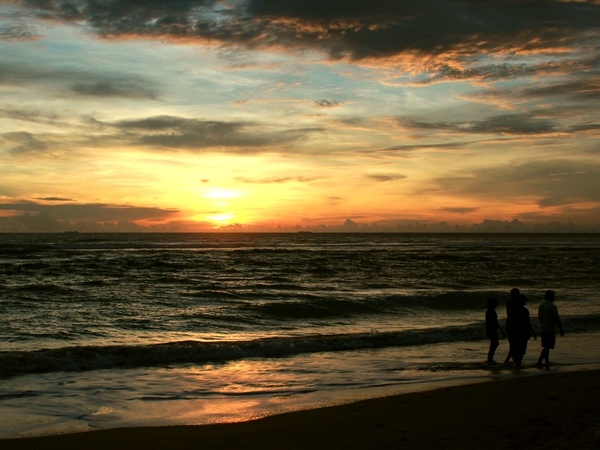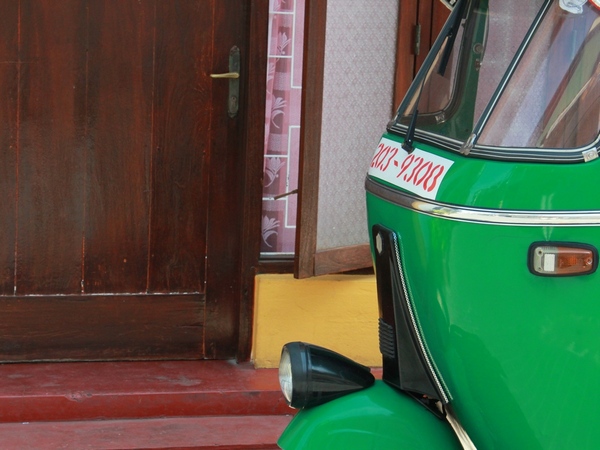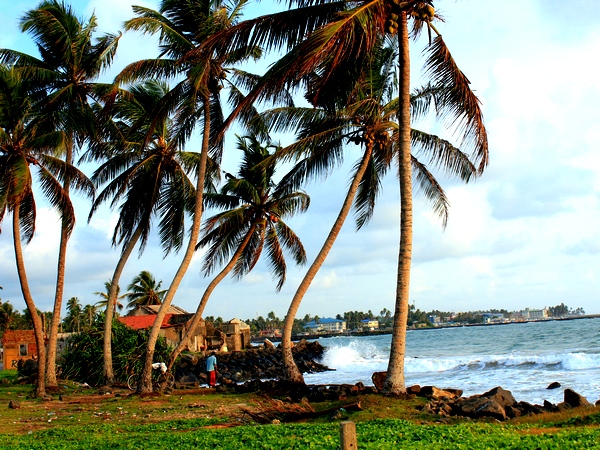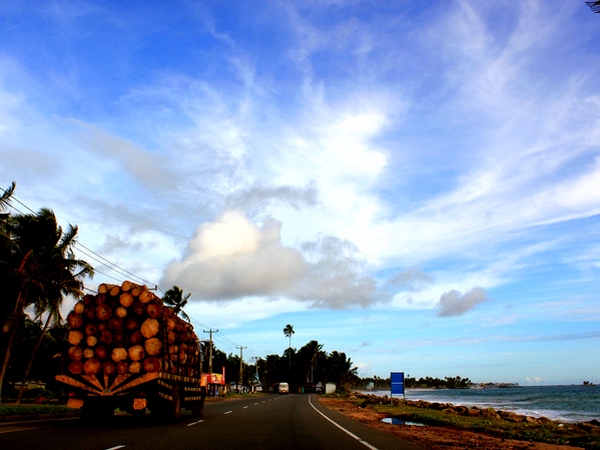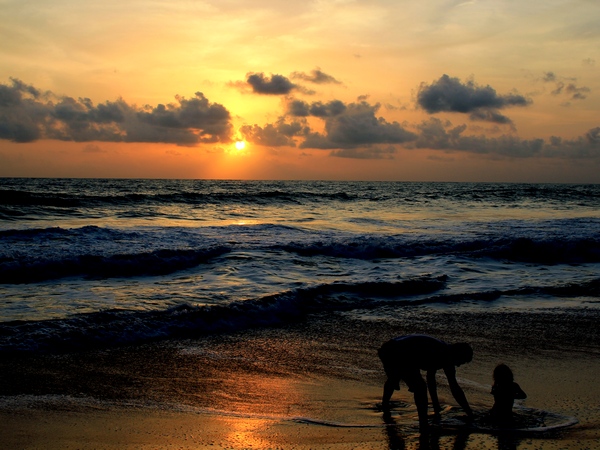 | « Back to article | Print this article |
PICS: Backpacking in Sri Lanka
You do not have to blow up a lot of money to travel in Sri Lanka. In the first of this three-part series, Abhishek Mande travels to Hikkaduwa and Galle.
Great many things have been said about Sri Lanka. Romantics have compared it a teardrop falling from the tip of the Indian Ocean. The Arabs called it Serendib from which originated that lovely English word -- serendipity that so wonderfully describes the occurrence of events by a happy coincidence. And long before the marketing geniuses sold us 'best in its segment' cars, the explorer Marco Polo had already made a case for Sri Lanka back in the 1300s calling it the finest island of its size in the world.
Even so, Sri Lanka doest not figure as the destination of choice amongst many Indians looking to make their first overseas visit. Surely, a trip to Sri Lanka doesn't necessarily give you the feel of having visited a 'foreign' land since it is geographically and climatically so similar to India.
Yet if you're on a really shoestring budget, Sri Lanka might just be the answer to your problems primarily because the Indian Rupee is twice as expensive as the local currency -- the Sri Lankan Rupee (LKR) and therefore technically opens up a lot more doors for you than in most South Asian countries.
Having said that, you must beware of touts, tuk-tuk (the local term for an auto rickshaw) drivers and guesthouses that will try to make the most of your 'foreigner' status and can jip you before you know it.
Many operators in India will be happy to arrange tours for you and your family, but if you don't mind roughing it out, Sri Lanka can be seen very easily from budget guesthouses and by public transport.
Since we were on a budget trip we decided to travel from Mumbai to Chennai by train and then take a flight to Colombo. In spite of paying for a First Class train ticket and an overnight halt in Chennai, we were saving a good couple of thousand rupees as opposed to a direct Mumbai-Colombo flight ticket.
However, if you have planned your trip well in advance you can get a good deal on the air ticket too.
Having recovered from the train journey (and a very loud and abusive rickshaw driver in Chennai) we reached the international terminal of the airport in Chennai much before our scheduled time of departure.
The plan was to land at the Bandaranaike International Airport around 3.30 pm; take the first bus out of the airport heading towards Hikkaduwa about 140km away where we'd booked a hotel for the night.
What we didn't factor in our grand plan was a five-hour delay of the SpiceJet flight we had booked ourselves on. As a result we took off around sunset and landed close to 7pm.
On the flipside, we managed to get a stunning view of the setting sun from the plane -- a sight I had only heard of but never once witnessed. It was, needless to say, indescribably beautiful.
By the time we were done with our immigration process it was close to 8pm leaving us no option but to take the Airport taxi to Hikkaduwa.
In spite of the currency difference, private transport continues to be extremely expensive in Sri Lanka even by Indian standards. We got a taste of it less than an hour after landing. The non-AC cab put us back by almost LKR 9,000 that roughly translates to about INR 4,500.
This was the only time we took a private taxi on our journey but we would continue to feel the pinch each time we'd hire a tuk-tuk, which in Colombo have meters and start at LKR 50 per km. Elsewhere, the fare seems to depend entirely on how generous or otherwise your driver is feeling that day.
PICS: Backpacking in Sri Lanka
The good part about our first leg of journey in Sri Lanka was the Southern Expressway, Sri Lanka's first ever access controlled highway that is promising to change the face of road travel in the island country.
Southern Expressway currently runs from Colombo to Galle (pronounced Gaul) and is one of the best roads to drive on in Sri Lanka reducing travel time between the two port cities from 4 hours to a little over 60 minutes.
The same however cannot be said for the other roads in the country. In spite of being a relatively small nation in size, travelling in Sri Lanka can be frustratingly time consuming.
Travelling from Colombo to Kandy, for instance, -- a distance of a little around 100 km -- takes anywhere between 3-4 hours by bus (and slightly longer by train). If you're covering great distances (ie anything more than 70km), be prepared to keep at least half a day aside for travelling.
It is possible to rent out self-driven cars from Colombo and drive around the country but getting a driver's permit can be far more exasperating than travelling itself; besides, it may not be the safest bet given the heavy traffic on main roads.
Some towns such as Hikkaduwa and Kandy have places from where you can rent out bikes -- motorised or pedal -- for the day. Some others such as Anuradhapura among others confounding only rent out bicycles.
Either way, these are usually shack establishments that do not bother about an international license or driver's permit and are happy to settle for just a copy of your passport. (Some of them ask you to surrender the original but after haggling eventually settle for a photo copy, though what they'd do with it should you go absconding with the bike remains a mystery to me.)
Like in Goa, the bike rental business in Sri Lanka is an unorganised sector and it boils down to how well you can negotiate with the dealer. The longer you want to rent out for, the lesser it will cost you per day.
In Hikkaduwa, the rates start from LKR 500 per day upwards depending on the bike you want. At Kandy, which we were given to believe has just one dealer, the rates are steeper -- about LKR 2,000 per day -- and you may have to settle for geared motorcycles rather than scooters.
Usually, the best person to get you a bike (as also most other things you may need) is your hotel manager.
PICS: Backpacking in Sri Lanka
Hikkaduwa is a sleepy beach town located a little over 100km from the city centre of Colombo. If you're flying in, making it your first stop is a terribly bad idea as we were to learn.
Travelling directly to Hikkaduwa from the airport comes either at great expense or an incredibly long amount of time that involves changing at least two buses or trains depending on your time of arrival.
In any case, your ideal first stop should be Negombo, another beach town barely 10 km from the airport and accessible by local busses and tuk-tuks (the latter should not charge you more than LKR 500)
We only managed a fleeting glance of the 100 meters around Negombo railway station on our way back home but our guide book informed us that the town is ideal for budget travellers with a slew of low cost guesthouses opening their doors for tourists such as us.
As in most beach towns in Sri Lanka, there is little to do in Negombo besides lazing on the sand and trying out the local fish (and of course booze). It is perhaps the most ideal way to start your trip. We skipped it in part because we already had made a hotel booking in Hikkaduwa for the night.
Hikkaduwa by day is reminiscent of South Goa, only much quieter. The nightlife in Hikka isn't much to speak of but the place does come alive during July/August during the annual beach festival that features a mix of international DJs and local performers. It is however far from being 'the biggest beach party in Asia' as its official website rather naively declares.
We landed late at night and hit the sack. The next morning after breakfast we decided to change to a beachside hotel. Whispering Palms is run by Christa and her son Yohaan and located less than 100m to the north of the very posh Citrus Hotel along Galle Road.
We struck a note of familiarity with Christa who'd spent the first 20 years of her life in Mumbai, our hometown and wanted to know everything about it from us!
The 27-year-old Yohaan is an enterprising young fellow who besides managing the hotel (which is also their family home) arranges for tuk-tuk tours and if you can talk him into it, even manages to get you a bike for the day from his friend across the road.
Bike in hand we decided to head south, to Galle along Galle Road.
PICS: Backpacking in Sri Lanka
For those who cannot afford the Southern Expressway toll, Galle Road continues to be the arterial road to travel between Colombo and Galle. Yet in parts, the road is no wider than two lanes and the buses and trucks zooming at insane speeds make it a dangerous to drive or ride on. If you've rented a scooter, it might be a good idea to stick to the left and keep a lookout for the numerous by lanes from which vehicles emerge with little or no warning.
In spite of the manic traffic Galle Road, flanked by tiny village houses on one side and the roaring Indian Ocean on the other, is also one of the most scenic roads in Sri Lanka.
At the heart of Galle, Sri Lanka's fourth largest city, is the old Dutch quarter quite simply known as the Fort, and one that holds pretty much everything that there is to see in Galle. The new town, where the bus and train stations are and where the commercial activity in Galle takes place, has all the charm of a dead dog's bottom.
Long before the British made Colombo a major port, Galle was an important trading hub thanks to its strategic position -- almost on the southernmost tip of the country -- and a great natural harbour.
In 1589, the Portuguese established their presence here and constructed a small fort called Santa Cruz. After Galle fell into the hands of the Dutch, they expanded the Portuguese fortifications, enclosed the entire sea-facing ridge, established a street plan, sewer system and a series of bastions that survive to this day.
Somewhat ironically, the heavily fortified city of Galle fell to the British in 1796 without so much as a gunshot being fired, following a transfer of power when the Dutch were defeated in the Napoleonic Wars.
Much of the Dutch legacy, though, remains intact in the form of quaint colonial villas and churches along sleepy streets.
There really isn't much to see in Galle, barring a couple of museums in the area, but its quiet, understated charm can keep you busy doing nothing for hours on end.
If you've arrived at Galle in a vehicle, leave it in the parking lot near the Maritime Museum (even though you can park almost anywhere in the area) and go around on foot. Don't forget your camera; you'd be kicking yourself if you do.
There are a lot many swanky cafes to choose from in Fort -- for a quick bite or an elaborate meal -- though most dishes are usually tempered down to suit the western palette. Authentic Sri Lankan cuisine is served in the new town though chances are it'll be tad too spicy for your liking.
We tried out a local joint in the market just off the main street, a stone's throw away from the city's bus stand and it was spicy enough to put me off Sri Lankan food for the next couple of days. I was also quite put off by rice that smelt very different from the Surti Kolam I am otherwise used to having.
But while I was feasting on French fries for the next two meals, my girlfriend discovered her love for string and plain/egg hoppers. Made from rice flour, string hoppers are quite like noodles while plain hoppers are appams; egg hoppers are appams too, only much cooler because they have eggs in it! Mercifully I didn't encounter curries as spicy as the one in Galle and I did have considerable Sri Lankan food but I never really warmed up to its cuisine as I imagined I would.
The ride back from Galle to Hikkaduwa was memorable. As the sun set in the roaring Arabian Sea it was difficult to keep an eye on the road so we simply pulled over and watched the sun go down, arriving in Hikkaduwa just before the lights came out.
PICS: Backpacking in Sri Lanka
A young boy walked up to the service counter at a local eatery sporting white t-shirt that read: 'What do you do in Hikkado?'
It's close to 10am but Hikkaduwa is yet to wake up. Barring a few tourists the roads remain empty, cafes closed. In many ways the t-shirt sign, meant to promote Hikka, does indeed pose a question to which there's probably just one answer -- not a lot, unless of course you want to go snorkelling.
According to our guidebook there were plenty of sites to go reef diving or snorkelling in Hikka. It also told us that the coral reefs have lost their charm, most of them being dead white even as it suggested we drop the idea of going on a glass-bottom boat from which you see little but end up being poorer by a few hundred rupees or more.
Since one of us doesn't swim and the other is afraid of the sea we decided to give both a pass.
What we did however was head back south, towards Galle for a boat ride to Rathgama Lagoon about 10km from our hotel. We didn't come across the Blue Lagoon Boat House that offers rides in the lagoon but we did meet a local fisherman who was happy to take us around in his boat. It turned out cheaper -- LKR 1,000 for two hours -- and supremely blissful.
For the next two hours we put our cameras aside. All we heard was the lapping of the waves, chirping of the birds and watched the slow life around the lagoon as it unravelled itself to us ever so marvellously.
Sri Lanka was quickly turning out to be one of our most favourite places in the world.
